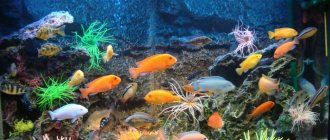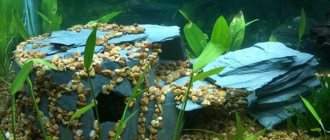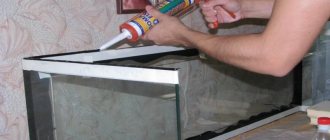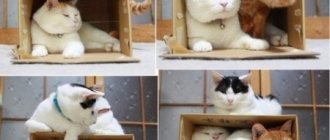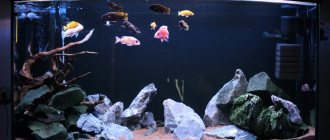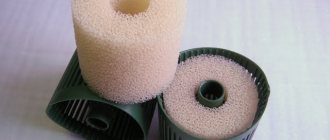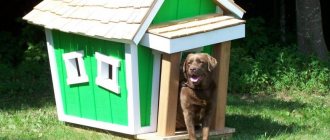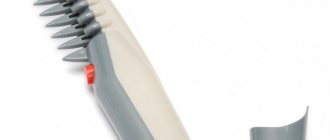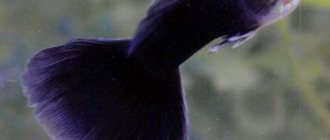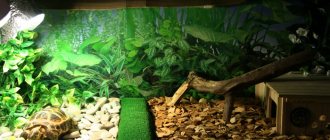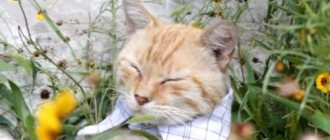Decorative background
Although the background for the fish does not play any role, it emphasizes the beauty of underwater inhabitants, highlights the decorative design and visually enlarges the water space.
Foam and film are used to create a decorative background.
You can find out more about backgrounds for aquariums in another article.
Styrofoam
Foam plastic is used to create a background because it is an inexpensive material from which it is not difficult to make decorations for an aquarium with your own hands. To create a background that resembles a rocky surface, foam is cut to the size of the glass, fired until it bubbles, and coated with a cement base. Once dry, place in the back.
Another option for using polystyrene foam, besides firing it, is to carve certain designs on it. Then you can also cover it with cement or non-toxic and safe paint.
Film
Most often, breeders choose black colors or underwater landscapes as a background in the interior. The color depends on the style of decoration and the presence or absence of artificial decorations. The color black is associated with the darkness of the deep sea. Films with designs of underwater plants, reefs, and corals also increase the volume of the tank and highlight the fish.
Films are sold in pet stores. They also print films to order with individual designs. After purchasing the film, it is important to properly glue it to the glass walls of the aquarium. Do this carefully, smoothing out any bubbles that form. PVC film is considered the most reliable. Its service life is several decades.
Selecting suitable soil
Soil is especially important for plant decoration; it provides support for the roots. When choosing a material, adhere to the following conditions: do not harm the fish. Many representatives of the underwater world love to dig at the bottom or swallow pebbles. The main thing is that they do not get injured or choke. The color range of the soil is important for shellfish and shrimp.
Aquarium background decor
Aquarium decor spongebob
Decor for an aquarium in the living room
Clay aquarium decor
The chemical composition of the bottom design plays an important role. Some materials increase water hardness, which is not suitable for all fish and plants. It is ideal to fill with coarse-grained clean sand, expanded clay or gravel chips (fraction up to 4 mm).
Aquarium decor
Decorative tree for aquarium
Artificial aquarium decor
Decor for aquarium shells
If you decorate the aquarium in a green style, with a large inclusion of algae and other plants, then it is preferable to decorate the bottom with a nutritional composition. It is sold ready-made or mixed independently from sand, garden soil and clay.
Aquarium decor in the form of a steering wheel
Aquarium soil
Decorative grotto for an aquarium
Decor for an aquarium with algae
Stones
The simplest means of decoration are stones. They, like decorations for the aquarium, are bought in specialized stores or collected when going out into nature. Choose smooth rocks without sharp edges or cracks that could injure the fish. You also need to pay attention to the composition of the stone. It should not contain limestone. Long-term release of alkali into the water will harm underwater inhabitants. To test a stone for the presence of alkali, you will need vinegar. If vinegar applied to a stone begins to hiss and foam, then the stone is not suitable.
If you do collect stones in nature, then the first thing you should do is disinfect them. Disinfection is carried out using boiling water. To begin with, wash the stones and remove dirt from cracks and crevices with a brush. Then they put it in water and boil for 15 minutes to destroy all bacteria and viruses that are dangerous to fish.
Stones are not only used to line the bottom, but are also used to decorate the aquarium. From them you can make stone structures with your own hands: caves, grottoes or slides.
You can learn more about choosing stones for an aquarium in this article.
Recommended vegetation for an aquarium
Plant decor plays a significant role in creating the overall composition, enriches the environment with air and serves as additional feeding for the fish. These can be natural plants or artificial ones.
The last option is convenient in terms of care:
- easy to clean from algae deposits;
- always beautiful;
- neutral to water composition;
- do not attract fish (in terms of food).
It is more rational to combine living and artificial plants (flowers), which will enrich the landscape and maintain biobalance. Thus, some fish species spawn on algae.
Magnificent floral decor
Aquarium decor volcano
Aquarium decor grotto
Aquarium accessories
When planting vegetation, adhere to the basic principles:
- the foreground is decorated with low-growing specimens and grass;
- the back and side walls are filled with long algae and lush plants;
- Spreading bushes are planted in the middle.
It is recommended to combine plants not only by leaf size and stem growth, but also by color scheme. Due to this, the impression of a multi-tiered landscape appears, imitating a wild water landscape.
Aquarium decor with stones and corals
Aquarium decoration
Decor for aquarium boulders
Decor for an aquarium with corals
Wooden decorative elements
Wooden accessories are purchased at the store. But you can make the decor of an aquarium with your own hands. Not all branches, driftwood and sticks found outside are suitable for decorating an aquarium.
- Pay attention to the type of wood, if possible. Coniferous species are not suitable. In the water, they begin to secrete resinous enzymes that negatively affect fish. Also avoid branches from oak trees. Tannins are released from them.
- Choose only healthy branches. Even a small lesion on the bark will cause infection and rapid rotting of the tree.
- Before making decorations for an aquarium from branches, they are boiled for a long time in salted water and then soaked.
Pipe shelters
A simple, inexpensive and quick way is to make shelters for the inhabitants of the aquarium from plumbing polypropylene pipes.
The diameter of the pipes is selected depending on the size of the aquarium, fish, and the wishes of the owner.
Manufacturing stages:
- Cut the pipes to the required length.
- Prepare multi-colored small pebbles (soil).
- Carefully lubricate polypropylene blanks with silicone sealant.
- Place the pipe vertically in a container with soil and sprinkle it generously with pebbles. The dishes should be such that you can roll the tubes like a rolling pin with pressure for thorough gluing.
The product is allowed to dry and placed horizontally on the bottom of the aquarium.
Waterfall
The waterfall gives the aquarium a special beauty.
Waterfalls are divided into 2 types:
- Waterfall above the surface. It also performs a useful function - with the help of a flow of water, the water is aerated, that is, filled with oxygen. The sound of flowing water has a calming effect on a person.
- Underwater waterfall. This is just a decorated imitation of a waterfall, but it does not lose its beauty because of this. An underwater waterfall uses sand and a compressor.
Ceramic products
Ceramic elements are durable in aquariums. Ceramic pots or figurines are lowered to the bottom and firmly fixed. Some Chinese ceramic products emit substances that are harmful to fish health, so be careful when choosing.
General decorating rules
Sometimes aquarists get so carried away with decoration, forgetting that fish will live among this decor. The decor should first of all be comfortable for pets, and only then beautiful.
Therefore, when decorating, observe some design nuances and fundamental principles:
- Don't use too much decoration. Pisces need room to swim.
- It is advisable to place the decor in the back of the aquarium, and not in the central part.
- Using decoration, it is good to hide devices for fish life, for example, a filter, compressor, aerator.
Coconut
Shelters or houses made from coconut are often used to decorate an aquarium. To build a coconut shelter, choose a fresh and ripe nut without any damage. Get rid of the inside of the nut. Boil for 10 minutes in salt water, and then soak for another day in warm water.
Grotto
Grottoes are essential for an aquarium; fish use them as shelters and places to rest. Grottoes can be purchased, but they are not difficult to make with your own hands. Almost any material is suitable for production. It can be stones, shells, wood, ceramics, clay. With the help of safe and non-toxic glue and the selected material, the mainsail of various shapes is glued together. The grottoes look good among the algae thickets.
